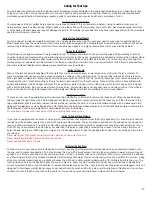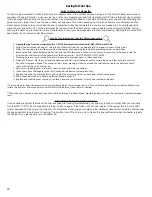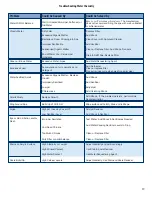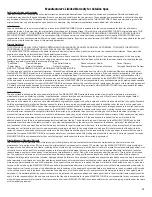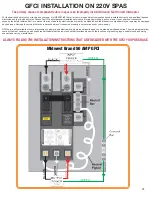
12
Your spa has been tested during the manufacturing process and some water may remain in the plumbing lines after testing leaving spots
on the acrylic or cabinet. Wipe the spa and cabinet with a clean soft rag. Do not use household cleaners that contain bleach or ammonia
(including most glass cleaners) because they will have an adverse effect on the surfaces and do not mix with chemicals used to maintain
water chemistry. Never use abrasive cleaners on the cabinet, cover or acrylic surface. They may do permanent, irreversible damage. To
remove incidental dust, dirt and debris that may have accumulated in the plumbing lines during shipping and installation, open the drain
bib and remove the filters, and run water through the filtration canister and jet lines until the water coming from the drain bib runs clear.
Never attempt any kind of service or cleaning when power is applied to the spa. Each time you remove the spa cabinet for any reason,
manually turn the GFCI off. Never leave the spa unattended while the exterior panels or cover are off the spa.
Step by Step Instructions to Fill the Spa with Water
1. Remove all of the screws that attach the access panel to the spa frame. In most models, the access panel is on the same
side as the topside controls.
2. Check for obvious signs of damage inside the cabinet including loose wires or broken pipes. If you see damage inside the
spa cabinet, call your local dealer for assistance.
3. Hand tighten the plumbing unions and check to be sure the slice valves are locked and in the “up” position. If they aren’t,
pull the “T” stem all the way up until you hear a “click” and attach the clip locks. Never operate the spa when the slice valves
are closed. Damage that occurs because the spa was powered on when the slice valves were closed is not covered by the
manufacturer’s warranty.
4. Remove the filter cover and basket from the filter assembly and store in a safe place.
5. Place the filter(s) inside the foot well while the spa fills with water. Never install dry filters in your spa.
6. Place a garden hose in the empty filter canister. Turn the water on. Filling the spa through the filter canister fills the pumps
and internal plumbing lines with water, reducing the risk of an air lock in the pumps(s) when power is applied. When the lower
plumbing lines are filled, water will begin flowing into the foot well, moving upward inside the spa. Continue filling the spa
until the water level is approximately one inch over the highest jets, excluding jets that are designed for neck and shoulder
massages. Failure to add enough water prevents adequate flow which will damage the pumps and heater. Damage that
occurs because the spa is not filled properly or from improper water levels is not covered under the manufacturer’s warranty.
7. Remove the garden hose and turn the water off.
8. Check the drain valve to be sure no water is leaking from it and that it’s properly sealed.
9. Replace the filter, skimmer basket and filter cover.
10. Check for leaks inside the spa cabinet, especially at the plumbing unions near pump(s),and pack. Hand tighten unions if
necessary. If the spa is leaking and the unions are tight DO NOT turn the GFCI on. Call your local dealer for assistance and
repair before applying power to the spa.
11. If there are no visible leaks inside the cabinet, turn the GFCI “on”
12. When power is applied to the spa, the spa controls will immediately begin a self check cycle, which can take up to 30
minutes.
Do not touch the buttons on your topside controls until
“PR”
appears on the topside display!
Make sure water is circulating through all jets, that the air controls, diverter and waterfall valves are functioning properly. If the spa is
functioning properly and there are no leaks inside the spa cabinet, reinstall the cabinet access panel.
There’s a fine line between too much water and not enough. If the water level is too low, air is sucked into the plumbing lines
which causes serious damage to the spa. If the water level is too high, lighting and audio components become submerged
causing them to fail prematurely. So how do you know when enough is actually enough?
It’s important to pay attention to the water level as bathers enter and exit the spa. The number of gallons displaced by one
person is lower than the number of gallons displaced by six people and the number of gallons displaced by six children
who weigh 50 pounds is lower than the number of gallons displaced by six adults who weigh 150 pounds. What may be the
perfect water level for six children may cause the spa to overflow with six adults, but six children might splash out more
water than six adults displace. You should expect to add or remove water depending upon use. Every time you exit the spa,
check the water level and add water if necessary.
The water level will vary depending upon the spa model you purchased. As a
general rule, when the spa is empty the water level should be at least 4 inches over the filter basket and below the perimeter lighting
and audio components.
Follow State, Local and Community requirements when disposing of the water in your spa. Because heavily treated water
may be harmful to the environment and some areas are prone to flooding some communities regulate or restrict the disposal
of the water from your spa. Typically, if the pH & chemical levels are correct, you can drain the water on your own lawn
provided it does not enter storm drains and there is no potential of erosion or flooding to surrounding properties.
The Water Level
Filling your Spa with Water
Disposing of Water

















